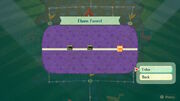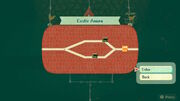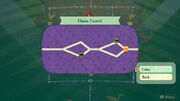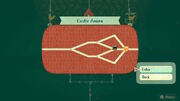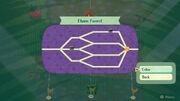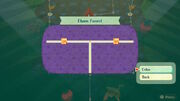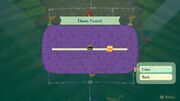
A picture of a path in Easin Hills.
The paths in Miitopia are where the player can fight off monsters, trigger events, or open chests. The player can view the paths already explored in every world there is, and they are a vital part of the game. Except for Darker Lord's Domain, all paths end with an Inn.
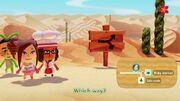
The game lets the player decide which path they will take.
Some paths include a decision into which way to go, and some paths have texts on them of what they are. The player can simply revisit the stage to explore all the paths. Occasionally, some of these splits are labeled with unique names.
Path completion in a stage is tracked by the bottom screen on the Nintendo 3DS version, while the Nintendo Switch version uses a mini-map due to the lack of a second screen, though the player will be first given a preview of the full map (complete or not) upon pressing "A" on a stage if it is already cleared at least once, at which point the player may confirm to explore said stage by picking "Enter".
If a stage is new or incomplete, it will be marked with a pink dot. If the player finished a decision path, but did not go the other way (one path complete, the other incomplete), the stage's node becomes gray. If the player finished the path(s) entirely, the stage's node becomes a yellow dot with a yellow flag.
In random dungeons[]
In random dungeons, a variety of stage layouts can be found, though randomly generated in a given random dungeon. The following lists the possible path patterns that can be generated.
All path patterns' names listed are conjectural and thus not official.
Straight[]
The straight path pattern is a single-way path with two spots for either an event or a chest before a monster encounter near the end.
Two-path (short)[]
The short two-path pattern has the single path branch into two which then converge near the end. On the upper path, the player will trigger a monster encounter followed by a chest, while the lower path will have the player trigger a random map event followed by a monster encounter. Another monster encounter is triggered at the converging point of the two paths.
Two-path (long)[]
The long two-path pattern has the single path branch into two similarly to the short version, with the obvious difference having longer distances than the latter. The upper path has two monster encounters followed by a chest, while the lower path has the chest being the second event trigger instead. Unlike the short variation, there is no monster encounter on the converging point.
Double kite[]
The double kite path pattern has the main path branch into two, the upper path leading to a monster encounter while the lower path leading to a chest. A random map event is placed on the first converging point. Afterwards, another similar branch is encountered but with the events encountered the other way around, meaning the upper path leads to a chest while the lower path leads to a monster encounter. The second converging point is marked by the Inn.
Two-path spread[]
The two-path spread pattern starts with a monster encounter in the middle of the straight line section of the path before the player can face the first path branching, which splits the path into two. The upper path has a monster encounter before the next branching, while the lower path has a random map event. Either path's branching allows the player access to a chest on the middle path, while both the topmost branch from the upper path and the bottommost branch from the lower path lead to a monster encounter each. All three paths converge into the end of the stage.
Three-path spread[]
The three-path spread pattern first branches into three, then each of three branches into two, with the lower branch from the topmost path converging with the upper branch from the middle path and the lower branch from the middle path converging with the upper branch from the bottommost path. Counting the two other branches, this requires a minimum of six ventures to fully complete a stage with this path pattern.
Two chests can be found in this kind of stage, and there are two different patterns for their locations:
- The first pattern has one chest located at the end of the very topmost path after the second split and another on the middle path after the first split.
- The second pattern has one chest located at the bottommost path after the first split and another at the end of the very bottommost path after the second split.
Easy/Tough[]
The easy/tough path pattern is mostly straightforward until it branches into an intersection, with the left being marked "Easy route" and the right being marked "Tough route". Because of this, monster encounter difficulty is based on the path picked. Unlike common stages, clearing one path will open the next stage of the respective side instead of opening the next possible paths at the same time when applicable. This path pattern can only be encountered if the random dungeon layout is the "Easy/Tough path" type, where this pattern is only used in the first stage.
Chest[]
The chest path pattern is also a straight line like the basic "straight" path pattern, but shorter and with only two event placements, the first of which can be either a monster encounter, a random map event, or even a regular chest, while the second is where the big chest can be opened.
Door key[]
The door key pattern is similar to the "straight" path pattern, but a chest containing the door key is always placed right before the Inn.

